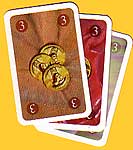Palazzo
Author: Reiner Knizia
Publisher: Ravensburger
Year: 2005
review by

| x |
|
|
|
|
|
|
|
|
|
|
|
|
|
|
|
|
|
|
|
|
|
|
|
|
|
|
 |
|
We are builders in the 15th century. Our task is to decorate the city of Florence with Palazzos of outstanding beauty. And we are really going to try our very best, because a emissary of the emperor himself will visit the city to judge our efforts! The buildings will be rated on height, number of windows and building material. The material to build the palazzos can be bought from the warehouse, or one of the four surrounding quarries. The building blocks are supplied in the form of building tiles with different stories (1-5), with 1 to 3 windows, and they are available in three different types of material. At the start of the game, one building tile is placed in each quarry and in the warehouse. The architect is placed in one of the four quarries. |
| x |
|
|
|
|
|
|
|
|
|
|
|
|
|
|
|
|
|
|
|
|
|
|
|
|
|
|
| In his turn a player can choose between three actions: take money, refill building tiles, or rebuild existing pallazos. If a player chooses to take money, money cards equal to the number of players plus one are turned over from the money deck. The active player can choose two cards, and the other players can pick one. If a player chooses to refill building tiles, two building tiles are turned over from the deck; the first tile is placed in the warehouse, and the second into one of the four quarries, depending on the number of windows displayed. Subsequently, the player can choose between buying 1 or 2 tiles from the warehouse, or auction the building tiles in one of the quarries. |
|
 |
| x |
|
|
|
|
|
|
|
|
|
|
|
|
|
|
|
|
|
|
|
|
|
|
|
|
|
|
 |
|
It costs 10 ‘money’ minus the number of building tiles in the warehouse to buy one tile from the warehouse. If a player decides for the auction, the architect moves clockwise to the next quarry, and all building tiles in that quarry are auctioned. Players may increase their bid in turn sequence until all players but one have passed. The winner of the auction takes all building tiles from the quarry.
There is something special about the money: there are three different currencies in the game that can only be used separately. If a player makes one bid during the auction in one type of currency, he has to use that same currency for all his other bids in that auction. Also when buying building tiles from the warehouse only one currency may be used. Exception: three different kinds of currency with the same value can be played together and always count as '15', no matter what the printed value.There are also ‘neutral’ certificates with value '2' that can be used together with any currency. Three of these also count as '15'.
|
| x |
|
|
|
|
|
|
|
|
|
|
|
|
|
|
|
|
|
|
|
|
|
|
|
|
|
|
|
The obtained building tiles are used to build palazzos. There are certain building rules to take into account:
-A player can have as many palazzos as he wants, but at the end of the game buildings of one story score minus points and buildings of 2 stories score no points. Only buildings of 3 stories and up are scored.
-The stories cannot be mixed up (a first floor may not be built on top of a third floor), but it is allowed to skip stories.
-Different types of material can be used together within one palazzo. But: bonus points can be earned for buildings composed of only one type of material.
|
|
  |
| x |
|
|
|
|
|
|
|
|
|
|
|
|
|
|
|
|
|
|
|
|
 |
 |
|
|
|
|
|
|
| x |
|
|
|
|
|
|
|
|
|
|
|
|
|
|
|
|
|
|
|
|
| x |
|
|
|
|
|
|
|
|
|
|
|
|
|
|
|
|
|
|
|
|
|
|
|
|
|
|
 |
|
|
|
|
|
|
|
|
|
|
|
|
|
|
|
|
|
|
|
|
|
|
 |
|
|
|
|
|
|
|
|
|
|
|
|
|
|
|
|
|
|
|
|
|
|
 |
|
|
|
|
|
|
|
|
|
|
|
|
|
|
|
|
|
|
|
|
|
|
| x |
|
|
|
|
|
|
|
|
|
|
|
|
|
|
|
|
|
|
|
|
|
|
|
|
|
|
 |
|
|
|
|
|
|
|
|
|
|
|
|
|
|
|
|
 |
|
|
|
|
|
|
|
|
|
|
|
|
|
|
|
|
|
|